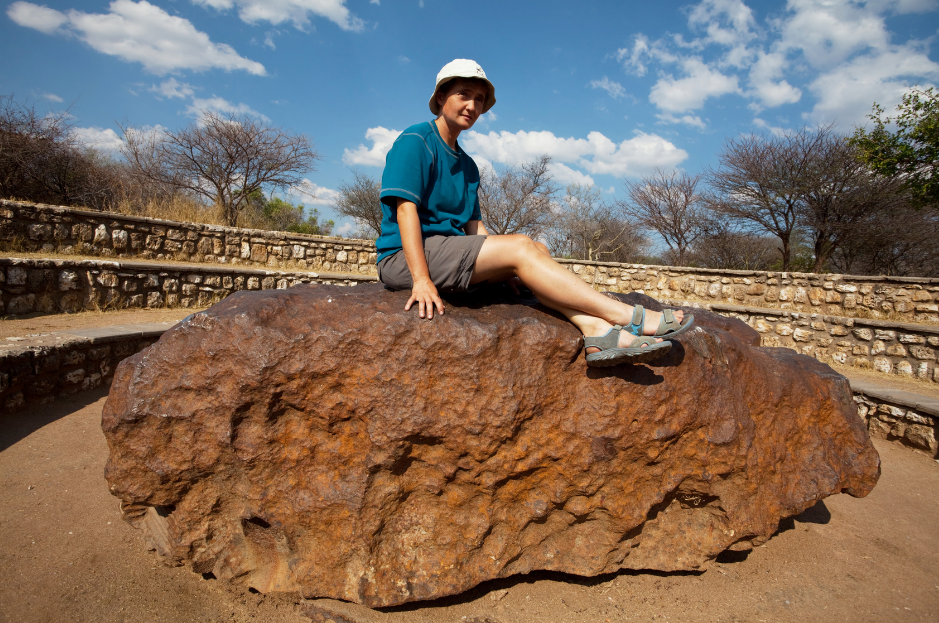
Facts About Meteorites
Before we take a deep dive into what a meteorite is, here’s some quick fire meteorite facts to kick things off.
- A meteoroid is a chunk of space rock. When it burns up while entering the Earth’s atmosphere, it is called a meteor. And if a piece of it lands, it’s called a meteorite.
- Millions of meteoroids travel through the Earth’s atmosphere every day, but most are small and burned up quickly. Very few reach the ground.
- When a meteoroid hits the atmosphere of the Earth, it can be travelling as fast as 130,000 mph (209,215 km).
- The buying and selling of meteorite pieces in South Africa is illegal. It is also illegal to export meteorites that landed in Australia as they are considered “property of the Crown.”
- A meteorite that is seen or detected as it lands are called “falls”, with those that are discovered later being referred to as “finds”.
- Space rocks that are less than 1 meter in diameter are called meteoroids. Those that are more than 1 meter in size are classified as asteroids.
- Of the 500 estimated meteorites that reach the ground every year, only five or six are recovered for scientists to study.
- A meteorite will hit a human being once every 180 years according to a study by Nature done in 1985. With Ann Hodges the only confirmed person to be hit by a meteorite in 1954, that means the next time somebody will be hit by a meteorite is 2134—an average of .0055 per year.
- The blast caused by the shockwaves of the Chelyabinsk meteor in Russia was picked up by infrasound sensors on the other side of the world.
Meteorite Facts – What Is a Meteorite?
A meteorite is a piece of space rock that has landed on Earth. These space rocks are mostly fragments of asteroids that have broken up. Sometimes, they can also be pieces of comets, moons, or even planets that have been blasted off.
Aside from the planets, there are many other smaller objects in the solar system that also orbit the Sun. Asteroids and comets are ancient objects that are the leftovers from the early solar system 4.6 billion years ago.
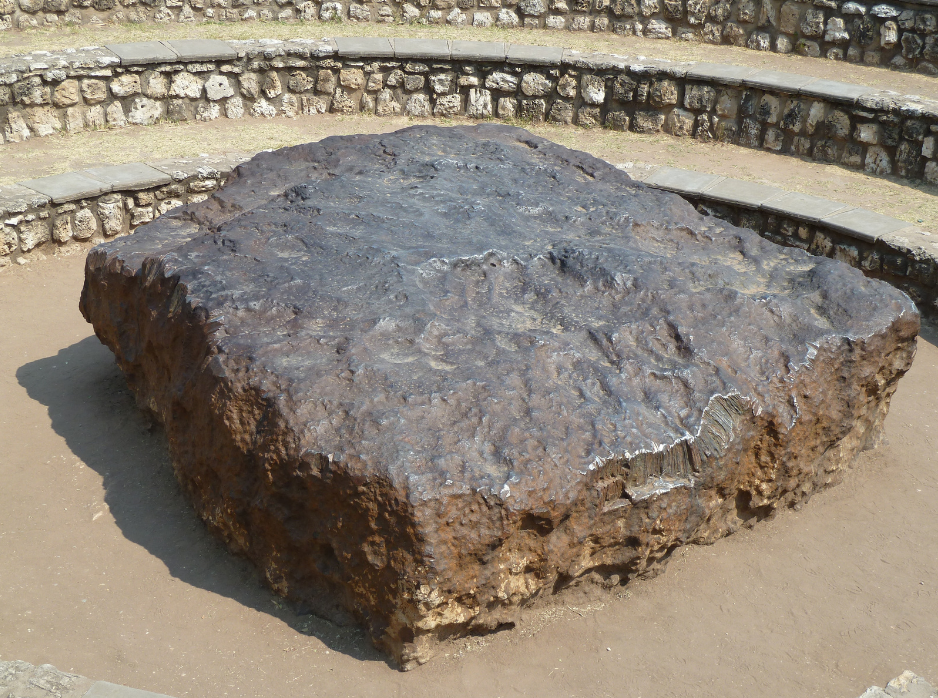
These objects have irregular shapes and they often collide with each other. When this happens, they break into smaller pieces and become meteoroids. Small Sun-orbiting objects in outer space with a diameter smaller than 1 meter are considered meteoroids.
When meteoroids enter the atmosphere, they burn and produce light streaks called meteors. It is not uncommon to see a few meteors per hour on a clear night, and during a meteor shower, you might see as many as 100 per hour.
Most of these objects are relatively small and get vaporized by our atmosphere. However, some larger pieces ranging from the size of a boulder down to a pebble make it through and reach the ground. When they finally reach the ground, they are already called meteorites.
Most meteorites come from asteroids, with a few being specifically attributed to the asteroid 4 Vesta. Some may come from comets and there are also meteorites that are of Luna (The Moon) and Martian (Mars) origins.
What’s the Difference: Meteoroids, Meteors, and Meteorite
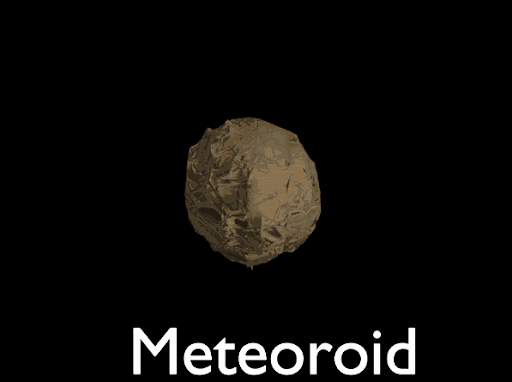
So what is the difference between meteoroids, meteors, and meteorites?
Basically, they are just the same thing. The difference in names only tells us if an object is inside or outside Earth.
So, a small rocky or metallic lump of material that travels through space is called a meteoroid. If they are very small (like the size of a dust particle) they might be called a micrometeoroid or “space dust.”
As these meteoroids travel through our atmosphere at a speed of 10 to 70 km/second, they are heated up by friction. This is what causes the long streak of glowing light called meteors. All but the very largest meteoroids are quickly decelerated to a few hundred km/hour by atmospheric friction.
If the object survives all this and eventually reaches the Earth, it is then known as a meteorite. Since the Earth’s surface is 71% water, most of these hit the ocean, and the rest are either spotted as they are falling or discovered by meteorite hunters after they hit the ground.
| What’s the Difference? | |
|---|---|
| Asteroids | Rocky objects that orbit the Sun. They are more than 1 meter in diameter and are mostly found in the Asteroid Belt between the orbits of Mars and Jupiter. |
| Comets | Icy objects that orbit the Sun. They are often found in the outer solar system beyond the orbit of Neptune. |
| Meteoroids | Small pieces of asteroids that have broken up. They can also be fragments of comets, moons, or even planets that have chipped off because of impact. These objects are 1 meter or less in diameter. They also orbit the Sun. |
| Meteors | The flashes of light that appear in the sky when meteoroids enter the Earth’s atmosphere. They are often called “shooting stars.” |
| Meteorites | Meteoroids that have landed on Earth. |
What Causes Meteorites?
Meteorites are called meteoroids when they are still in space. They are mostly caused by collisions of asteroids and other objects.
When these space fragments come close to Earth, they tend to be attracted by our planet’s gravity. Because of this, they fall to the Earth and become part of it. This only shows the continued accretion process of Earth as it gets dust, rock, and other materials from space.
Meteorites are common in the solar system. They are found on our Moon and other terrestrial planets as well. Unlike Earth, these objects do not have sufficient atmospheres to burn meteors. They are not protected from impacting bodies. As a result, bigger meteorites strike their surface which creates bigger impact craters.
Aside from that, the lunar craters remain mostly as they are because the Moon has very little geological activity. On July 15, 2014, the Martian rover Curiosity, found an iron meteorite on the red planet. This 7 feet (2 meters) wide meteorite is called “Lebanon.”
Where Do Meteorites Come From?
Meteorites are fragments of larger solar system bodies. Their objects of origin are called parent bodies. These are ancient objects that can be traced back to the early days of the solar system.
Most meteorites are from the asteroid belt. Located between Mars and Jupiter, the asteroid belt is like the dividing line that separates the terrestrial planets and the gas giants.
There are millions of asteroids in the asteroid belt. These objects are planetessimals that failed to accrete and come together to form a planet. Their irregular shapes are an indication that asteroids have undergone collisions with other objects.
Larger asteroids are believed to have undergone differentiation. Differentiation occurs when the internal structure of a body has different layers with different densities. An example of this is Earth which has a crust, mantle, and core.
The differentiation of larger asteroids could explain the different types of meteorites that we find on Earth.
Stony meteorites could be the crust and mantle the parent body, the iron meteorites the core, and the stony-irons could be the dividing layer between the mantle and core. Also, collisions between these asteroids could explain why these objects are sent into the Earth’s orbit.
Another source of meteorites are comets. Comets – such as Hale Bopp or Halley’s Comet – have icy compositions on the outside. These ices evaporate when they come close to the Sun, thus leaving a tail in their wake. Though they are mostly icy, comets are believed to have a rocky nucleus. Meteor showers occur when Earth comes across these fragments.
Aside from asteroids and comets, some meteorites on Earth are from Mars and the Moon. These fragments may have been ejected from the surface of these bigger bodies through asteroid collisions. Meteorites from Mars could also be sent into space through volcanic eruptions.
What Do They Look Like in the Sky?
Before an object hits the Earth’s surface, when it is still in the atmosphere, it is still a meteor. Meteors can produce glowing streaks of light as a result of friction. These light shows are easy to see as they are often called “shooting stars.”
Most meteors are from comets, which means they are mostly icy. Because of that, most meteors completely burn in the atmosphere and we cannot see meteorites after a meteor shower.
Meteor showers are named after the constellation of their apparent origins in the sky. Some of the most famous meteor showers are the Perseids and the Geminids from the Perseus and Gemini constellations, respectively. Though they are often seen against the dark night sky, some bright meteors can also be seen in daylight.
Meteorite Facts – Different Types of Meteorites
Meteorites are fragments of asteroids that have fallen to Earth. Scientists classify these objects based on their chemical makeup (the chemicals found in them), their isotopic composition (the specific types of each chemical element), and their mineralogy (the minerals they contain).
They are also classified by their type, with meteorites being classified as either stony, metallic, or a mixture of both.
Stony
Stony meteorites are the most common type of meteorite found on Earth. Also, they can easily look like the common rocks on Earth. Meteorites of this type are mainly composed of the silicate minerals, especially olivine and pyroxene.
There are two types of stony meteorites: chondrites and achondrites.
Chondrites
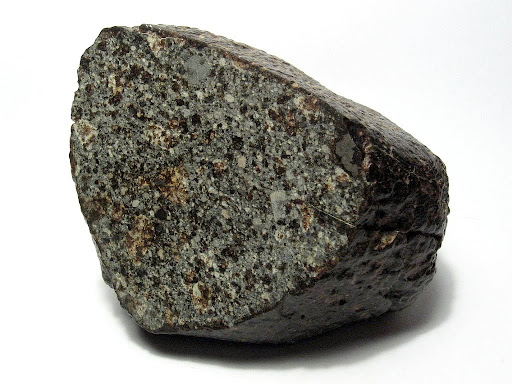
Chondrites look as if they have melted from high temperatures and rapidly cooled in the early history of the solar system. These molten droplets are called chondrules. Aside from olivine and pyroxene, chondrites are also made up of iron-nickel alloys which make them magnetic.
Achondrites
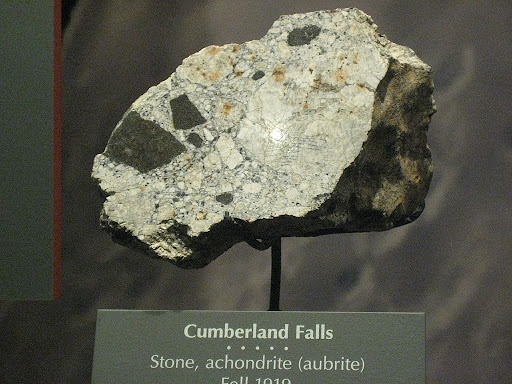
Achondrites are another type of stony meteorite. They have the same composition as chondrites but do not contain chondrules. They are also much rarer than chondrites.
Irons
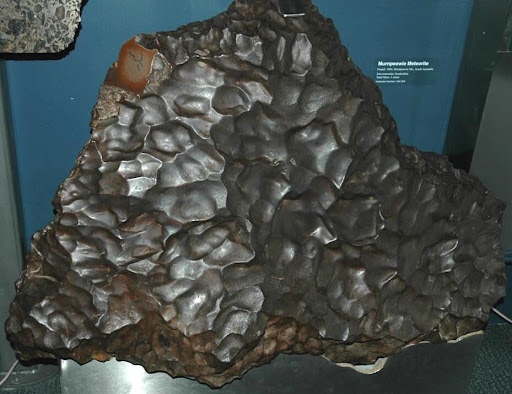
Iron meteorites are also called metallic meteorites. These objects mostly contain iron-nickel material. They are believed to be the cores of ancient asteroids that have melted in the past. Because of their metal composition, they are much denser and heavier than the common rocks.
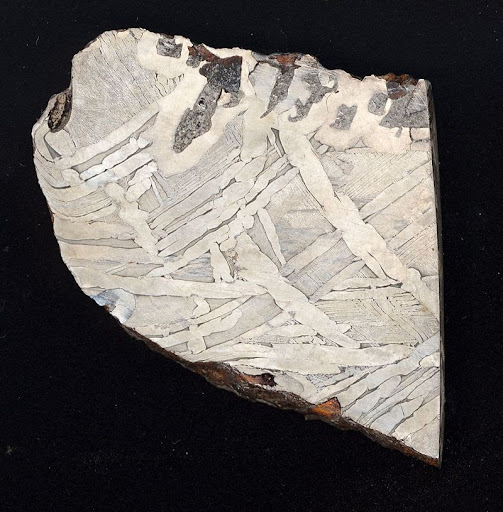
Iron meteorites have distinct Widmanstätten structures when cut. These are linear patterns that indicate the slow cooling of the molten metal in the past. They can also have “dimple-like or “thumbprint-like” structures called regmaglypts.
Stony-Irons
As the name says, stony-iron meteorites are a combination of the two previous types. They have roughly the same amount of silicates and iron-nickel alloy. It has two types: pallasites and mesosiderites.
Pallasites
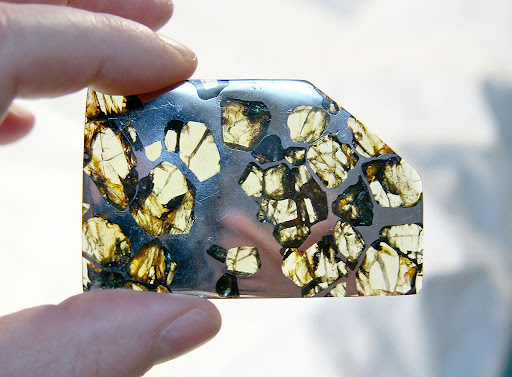
Pallasites are characterized by silicates embedded in a metallic matrix. These stony-iron meteorites are made of mostly nickel and iron, but also contain olivine crystals—a type of crystal that is common on Earth.
Mesosiderites
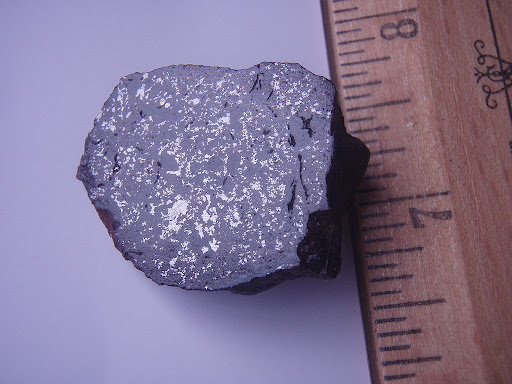
Mesosiderites are stony-iron meteorites that are breccias. Breccia occurs when the stony and metallic fragments are cemented together.
Meteorite Facts – Famous Meteorites
Throughout history, many memorable meteorites have touched down on our planet’s surface. Some of the most famous include:
Hoba Meteorite
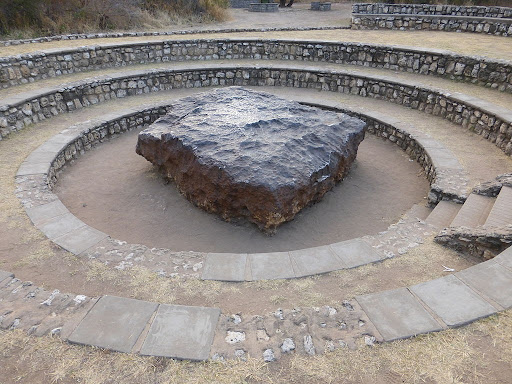
Weighing in at a whopping 60 tons, this is the largest known meteorite on the planet. It can be found right where it originally impacted, in Namibia, Africa. It is mostly composed of iron with nickel and other trace elements.
The Hoba Meteorite struck down over 80,000 years ago and was not discovered until 1920, but is now a National Monument with thousands of visitors every year.
Willamette Meteorite
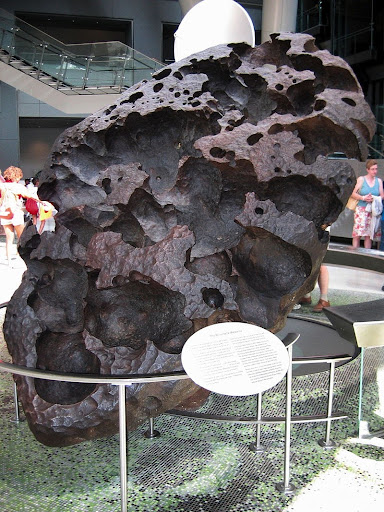
The Willamette meteorite is the largest meteorite ever found in the United States at 15.5 tons and stands ten feet tall. It is a pitted iron meteorite which is believed to be the remains of the iron core of a planet destroyed in a collision billions of years ago.
It landed around 1,000 years ago and was discovered by Westerners in 1902. Though, it was long revered by the Native American Clackamas tribe as a healing source they called Tomanowos.
Sylacauga / Hodges Meteorite
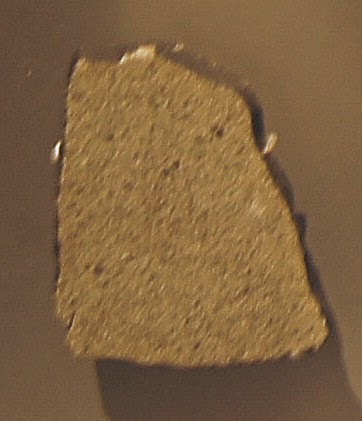
Sometime in the fall of 1954, a 34-year old woman named Ann Hodges was napping on her sofa when an 8.5lb meteorite smashed through her window and struck her on the hip. She was bruised, but otherwise unharmed by the meteorite her neighbors described as a “fireball shooting through the sky.”
The Sylacauga meteorite became known is also called the Hodges meteorite after the woman that it hit. This incident gained popularity worldwide because it was the only confirmed case of a person that was hit by a meteorite.
Allende Meteorite
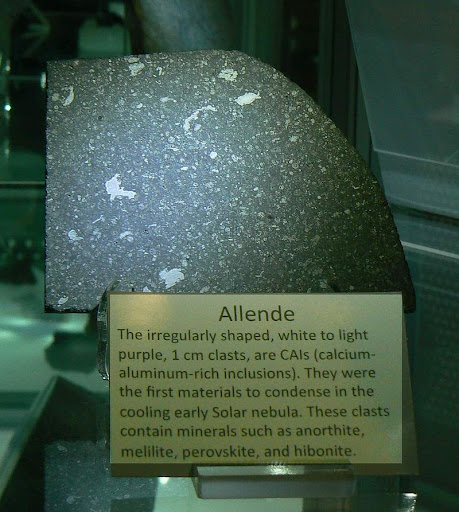
This meteorite crashed to Earth over Mexico in 1969. It was originally about the size of a car before it broke into hundreds of fragments that weighed several tons in total. It is one of the most studied meteorites of all time and a prime example of a carbonaceous chondrite.
Dating back to the formation of the Sun and the planets 4.6 billion years ago, carbonaceous chondrites are among the most primitive solar system materials known to man. They are made of silicates, oxides, sulfides, water, organic compounds, and various different minerals.
Chelyabinsk Meteorite
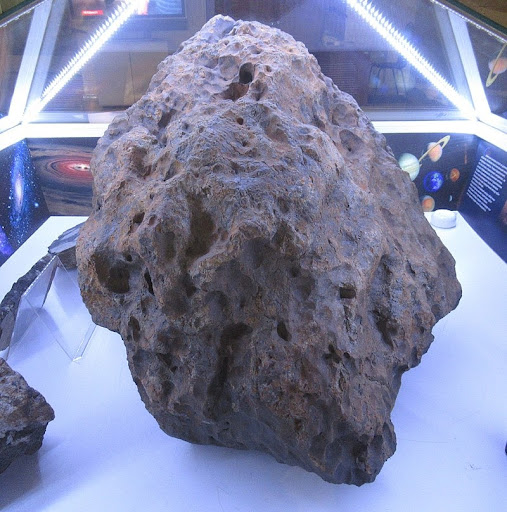
The Chelyabinsk meteorite made passage through the Earth’s atmosphere on February 15, 2013. It was a very bright meteor which many people were able to take videos of. The asteroid impactor is said to be as large as a six-story building.
The meteor caused shockwaves that caused damage to properties and injured some people. It exploded in the atmosphere which scattered its fragments over Chelyabinsk, Russia. The meteorite pieces are classified as ordinary chondrites. One of the largest fragments of the meteor landed in Lake Chebarkul where it crated a 6-meter crater.
Allan Hills 84001
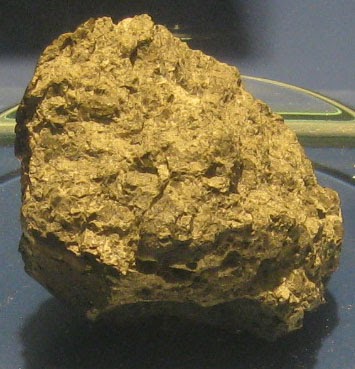
Allan Hills 84001 is a rare meteorite that came from Mars. It was named after Allan Hills, where it was found in Antarctica. This meteorite had a mass of 4.3 pounds (1.93 kg) when it was discovered.
It was believed that this meteorite was blasted off from the Martian surface through an impact event on the planet roughly 17 million years in the past. Some researchers proposed that it may contain evidence of extraterrestrial life.
This caused controversy for some time but it was later found out that the organic molecules on the meteorite were from abiotic processes.
Cape York / Innaanganeq Meteorite
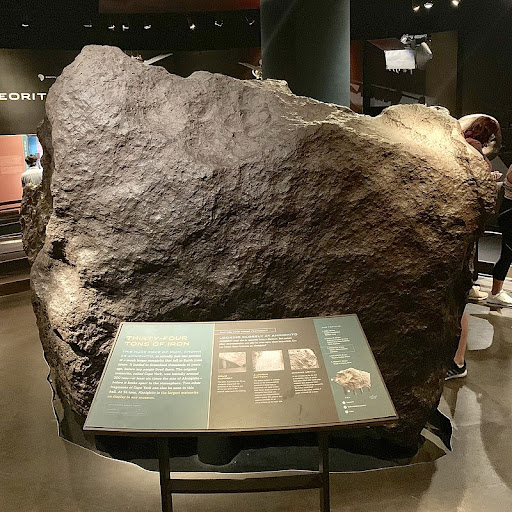
The Cape York meteorite is among the largest iron meteorites discovered on Earth. It landed on Greenland over a thousand years ago.
There are a couple of these meteorite fragments which the Inuit gave different names. The people that used to live near these meteorites used them to forge metal tools. One of the fragments is called Ahnighito which means “the Tent.”
It is now placed in the American Museum of Natural History. At 34 tons, it was the second-heaviest meteorite that was transported and relocated.
Orgueil Meteorite
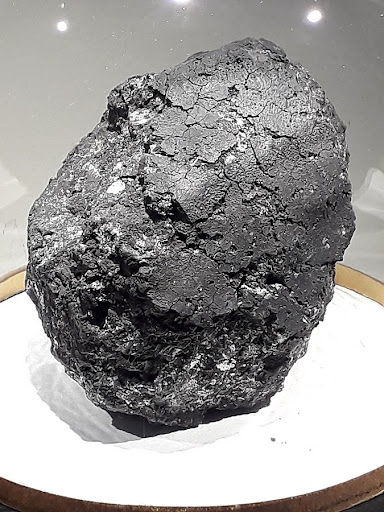
The Orgueil meteorite is a carbonaceous chondrite that fell in southern France in 1864. This is one of the most-studied meteorite because of its ancient composition.
This meteorite has very similar composition as the Sun and the primitive solid bodies that formed when the solar system just formed. Roughly 20 fragments of this meteorite were found. It was once also believed to contain traces of extraterrestrial life but this claim was later dismissed.
Brenham Meteorite

The Brenham meteorite is a pallasite, a type of stony-iron meteorite. It fell around 20,000 years ago and was found in 1882 in a small town in Kansas, United States. It was the impactor that created the Haviland Crater.
This meteorite displays the distinct yellowish olivine that pallasites have when cut.
Seymchan Meteorite

The Seymchan meteorite is stony-iron meteorite found in Russia in 1967. Its parasitic nature was just recently discovered because some fragments of this meteorite have olivine crystals while the others did not. The Widmanstätten pattern is also seen on some samples of this meteorite.
How To Tell Meteorites From Common Earth Rocks
Meteorites can look just like the common rocks we have on Earth. However, what sets them apart is their dark appearance. These objects burned when they entered the Earth’s atmosphere which is evident by their dark exterior.
Meteorites contain iron and other denser materials. Because of that, they are usually heavy relative to their size. The iron in metallic meteorites makes them magnetic. Aside from the burnt appearance, they also have unique pits called “regmaglypts.”
Regmaglypts are dimple-like structures that are often found on bigger meteorites. They are also characterized by “fusion crust,” the shiny appearance caused by abrasion when the object was travelling through the atmosphere.
To know the difference, meteorites do not contain light-colored crystals like quartz. Also, you can scratch it to an unglazed ceramic surface. Most meteorites, if not all, would not leave a streak.
More Interesting Meteorite Facts
- About 66 million years ago, about 60% of life on Earth vanished because of a large asteroid impact. It is believed to be the event that made the dinosaurs extinct. The impact occurred in the Yucatán Peninsula which left the Chicxulub crater.
- The impact that made the Chicxulub crater has a size around 11 to 81 km in diameter. It was said that the energy blast that it caused is equivalent to around 21 to 921 billion times the Hiroshima bomb.
- It is estimated that about 48.5 tons or 44 tonnes of debris from space fall to Earth every day. About 99% of this is made up of micrometeorites. These are dust-sized and even microscopic meteorites that are all around us. Because they are so small, it is easier to find them in remote places like deserts and Antarctica.
- There are about 60,000 meteorites found on Earth. Out of that number, around 126 of them are believed to be from the red planet, Mars.
- One of the most well-preserved impact craters is the Barringer Meteor Crater in Arizona. The fragments from the object that made this depression are called the Canyon Diablo meteorite.
- Taoudenni 002 is the largest Martian meteorite found on Earth. Discovered in 2021, this uncut meteorite weighs 32 pounds or 14.5 kilograms.
- The unique Venus flytraps are thought to have extraterrestrial origins. That is because these carnivorous plants are often found in areas where meteorites have fallen!
Meteorite Facts – Sources:
https://www.usgs.gov/faqs/i-think-i-found-meteorite-how-can-i-tell-sure#:~:text=Meteorites%20are%20fragments%20of%20rock,fall%20to%20Earth%20from%20space.&text=Meteorites%20have%20several%20properties%20that,metallic%20iron%20and%20dense%20minerals.
https://www.tulane.edu/~sanelson/Natural_Disasters/impacts.htm
https://en.wikipedia.org/wiki/Stony-iron_meteorite
https://www.nationalgeographic.org/encyclopedia/meteorite/#:~:text=More%20than%2060%2C000%20meteorites%20have,types%20has%20many%20sub%2Dgroups.
https://en.wikipedia.org/wiki/Chelyabinsk_meteorite
https://en.wikipedia.org/wiki/Allan_Hills_84001#Hypothetical_biogenic_features
https://en.wikipedia.org/wiki/Cape_York_meteorite#History
https://www.britannica.com/topic/Orgueil-meteorite
https://en.wikipedia.org/wiki/Brenham_(meteorite)
https://en.wikipedia.org/wiki/Seymchan_(meteorite)
https://www.bbc.co.uk/programmes/articles/5y0tp4GCmg7rFWXDMCb0bqF/mighty-meteorite-facts
(https://facts.net/meteor-facts/)
Meteorite Facts – Image Sources:
Meteoroid, meteor, meteorite: https://upload.wikimedia.org/wikipedia/commons/6/63/Meteoroid_meteor_meteorite.gif
Chondrites: https://upload.wikimedia.org/wikipedia/commons/7/74/NWA869Meteorite.jpg
Achondrites: https://upload.wikimedia.org/wikipedia/commons/thumb/a/ab/Cumberland_Falls_meteorite.jpg/1024px-Cumberland_Falls_meteorite.jpg
Irons: https://upload.wikimedia.org/wikipedia/commons/7/79/Murnpeowie_meteorite.jpg
Widmanstätten pattern: https://upload.wikimedia.org/wikipedia/commons/thumb/e/e7/Seymchan.jpg/800px-Seymchan.jpg
Pallasites: https://upload.wikimedia.org/wikipedia/commons/thumb/0/00/Esquel.jpg/1024px-Esquel.jpg
Mesosiderites: https://upload.wikimedia.org/wikipedia/commons/thumb/d/d9/Vaca_muerta_mesosiderite.jpg/1024px-Vaca_muerta_mesosiderite.jpg
Hoba meteorite: https://upload.wikimedia.org/wikipedia/commons/thumb/a/a7/Hoba_meteorite_%2815682150765%29.jpg/1024px-Hoba_meteorite_%2815682150765%29.jpg
Willamette Meteorite: https://upload.wikimedia.org/wikipedia/commons/thumb/c/cc/Willamette_Meteorite_AMNH.jpg/800px-Willamette_Meteorite_AMNH.jpg
Sylacauga / Hodges Meteorite: https://upload.wikimedia.org/wikipedia/commons/3/39/Sylacauga_meteorite%2C_Smithsonian_Natural_History_Museum.jpg
Allende Meteorite: https://upload.wikimedia.org/wikipedia/commons/thumb/d/d2/Allende_meteorite_slice_ASU.jpg/800px-Allende_meteorite_slice_ASU.jpg
Chelyabinsk Meteorite:
https://upload.wikimedia.org/wikipedia/commons/thumb/2/20/Chelyabinsk_meteorite_Historical_Museum_1.jpg/800px-Chelyabinsk_meteorite_Historical_Museum_1.jpg
Allan Hills 84001: https://upload.wikimedia.org/wikipedia/commons/3/35/ALH84001_meteorite_Smithsonian.jpg
Cape York / Innaanganeq Meteorite: https://upload.wikimedia.org/wikipedia/commons/thumb/8/87/Ahnighito_AMNH%2C_34_tons_meteorite.jpg/800px-Ahnighito_AMNH%2C_34_tons_meteorite.jpg
Orgueil Meteorite: https://upload.wikimedia.org/wikipedia/commons/thumb/c/c7/M%C3%A9t%C3%A9orite_Orgueil%2C_exposition_M%C3%A9t%C3%A9orites%2C_Mus%C3%A9um_national_d%27histoire_naturelle_de_Paris.jpg/675px-M%C3%A9t%C3%A9orite_Orgueil%2C_exposition_M%C3%A9t%C3%A9orites%2C_Mus%C3%A9um_national_d%27histoire_naturelle_de_Paris.jpg
Brenham Meteorite:
https://upload.wikimedia.org/wikipedia/commons/thumb/d/dc/Brenham_AMNH_2.jpg/1024px-Brenham_AMNH_2.jpg
Seymchan Meteorite: https://upload.wikimedia.org/wikipedia/commons/thumb/2/27/Seymchan_meteorite.jpg/1024px-Seymchan_meteorite.jpg